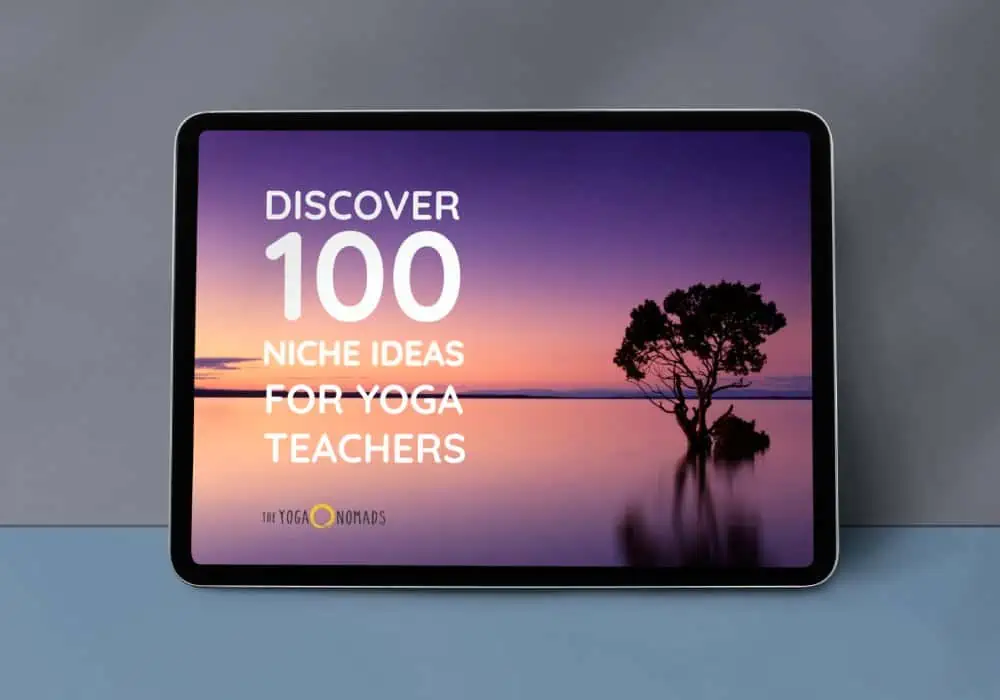Listen to this article:
Quick Tip: Yoga themes enhance the class experience by providing focus, connection, and inspiration, ultimately leaving a lasting impact on students.
Yoga is more than a meditation or an exercise; students are looking for an experience that they can’t get elsewhere. The best yoga teachers offer a streamlined experience to accomplish a clear goal or achieve a certain state of mind. The most memorable yoga classes of my career were centered around a theme that threaded together the entire class, from beginning to end.
Defining a yoga class theme helps clarify your planning and keeps you inspired. By setting a clear intention, you can thoughtfully design your sequence with specific cues and motivational stories to guide students through the class. Themes help create a connection with your students and an experience that impacts people long after they leave the mat.
Undoubtedly, you’ve been touched by yoga. Something about the practice keeps you coming back to your mat day after day.
It starts in your physical body. You began by noticing a difference in mobility and flexibility. Perhaps you also gained more strength and muscle definition.
These positive changes drove you to continue to test the boundaries of your physical form on your mat.
Then like magic, over time yoga seeped through to your mental body. The opening you began to feel in your body transcended to your mind.
This mental openness helped you move throughout your days with more peace and clarity… more grace with every step.
To reach these heightened states of awareness, you sought out the instructors who took you to those places with ease. The ones who were able to deliver a thought-provoking theme for you to ponder during and well after the class ended.
Prefer video? Here’s one of the top yoga themes for every season and occasion:
Contents
Why Use a Yoga Theme?
As yoga instructors, we all wish to be that teacher who has made a significant impact on our students. The one who can deliver yoga themes so eloquently, it reaches the masses and infects them with learning and discovery. The one who keeps the students coming back for more .
Choosing yoga class themes should be the heart of building a yoga sequence. It is arguably the most difficult element of guiding a yoga class, but also the most important.
A theme is like the guiding lighthouse of your class. It builds trust between you and your students while also helping them generate insights about themselves, their bodies, and their lives. Ultimately, uniquely themed classes can be what differentiates you from other instructors, leading to higher attendance rates and potentially higher income as a yoga teacher.
I’ve provided 44 theme ideas for you to choose from below. Then, read how to apply a theme to a yoga class.
44 Yoga Class Themes
Yoga themes can be personal and spiritual, seasonal, or focused on a specific part of the body.
Free download: 100 Niche Ideas for Yoga Teachers
Download nowGet started by choosing one of the 44 themes below to incorporate into your next class. Consider what it means to you and how you can tie in your own life experience. Use your intuition and your training to choose asanas, mudras, meditations, and sequences that will weave the thematic thread throughout the entire class.
Spiritual and Personal Yoga Themes
When choosing a spiritual theme, consider starting the class with a personal life story or an inspirational quote that weaves the theme into the sequence. Sharing your life lessons in between poses can add a lot of value to the overall class experience. Remember to be vulnerable and open up about your unique journey. Vulnerability helps connect you more deeply to your students. It also gives them the space to reflect and open their hearts and minds as well.
- Letting Go: It is said that many of our old emotions and memories are held deep in our hips. This theme is the perfect opportunity to dive into deep hip-opening Yin Yoga and light flows that include Butterfly Pose, Low Lunge, Warrior Poses, and Pigeon Pose. Inspire your students with guided pranayama breathing focused on long, slow exhales that release tension from the body. Use the quote, “Inhale the future. Exhale the past.”
- Self-Discovery: A self-exploration theme is perfect for yoga retreats or longer classes. This is an opportunity to delve into purposeful questions associated with poses that stimulate the Solar Plexus Chakra, including Ardha Matsyendrasana, Bow Pose, and Locust Pose. You can also repeat the Bija mantra “RAM” to activate the chakras and incite spiritual exploration of self.
- Third Eye Opening: This pinnacle chakra is associated with wisdom, clarity, and intuition. Shoulder Stands, Child’s Pose, and Hero Pose are examples of third-eye activating asanas that can be combined with blue light or jasmine aromatherapy.
- Gratitude: A Vinyasa flow is the perfect opportunity to focus on cultivating gratitude. Guide students to focus on things they are grateful for while flowing between asanas.
- Presence: Deep breathing and pranayama exercises are key for this theme. Create a class centered around a quote, such as “Change only happens in the present moment. The past is already done. The future is just energy and intention.” ― Kino MacGregor
- Heart Centered / Love: The Heart Chakra is a sensitive place that is often closed off in the modern world. Inspire your students to cultivate deeper compassion for themselves and others. Tell a story about a time you opened your heart or somebody opened up to you. Focus on heart-opening poses that create length in the spine and release tension built up in the chest and upper back.
- Beginner’s Mind: If you have any unique variations of yoga poses that most people haven’t tried before, a “beginner’s mind” themed class is a great place to put them into play. Use the zen quote “In the beginner’s mind there are many possibilities, but in the expert’s there are few”.
- Non-Attachment: Aparigraha, or non-attachment, is the final Yama of Patanjali’s Eight Limbs of Yoga. You can tell a story about minimalism or an interpretation of “it’s the journey, not the destination”. This class will remind students not to be attached to physical possessions or attached to the outcomes of their experiences.
- Non-Judgment: Incorporate inspirational stories of your own journey of releasing the need to judge yourself and compare to others.
- Alignment: This theme is an excellent opportunity to practice your hands-on adjustments of students. Creating physical alignment is a metaphor for mental and spiritual alignment with personal purpose and values. Always ask before making adjustments, and help students learn how to better stack their hips, shoulders, etc. during asana practice.
- Unity: The perfect theme for group yoga, especially couples, teams, or school retreats! Empower your students to practice their communication skills and get out of their comfort zone by trying acro yoga with a stranger. Try out a few group yoga poses for team-building and unifying.
- Breath: We are always focused on pranayama, however a breath-themed class should go deeper into the anatomy and yogic philosophy surrounding breath. Use slow-moving flows to thoroughly integrate each inhale and exhale with a movement.
- Benefits of Stillness: Restorative and Yin Yoga poses with plenty of yoga cushions and blankets are sure to bring your students into a restful, still state of mind.
- Quieting the Mind: Sometimes the most challenging classes are the best for a reeling mind. Use this theme as an opportunity to dig into Ashtanga flows and long holds of balancing poses.
- Surrender: Deep hip-opening poses are the ultimate surrender to what ails our minds. Create a safe space with aromatherapy, slow soothing music, and long slow breathing.
- Creating Space: This is a theme all about lengthening. Instruct students to create length in their spine while simultaneously making space for new experiences and self-discovery in their lives. Physical metaphors about space are very valuable in this context, for example, “
- Expansion: I always start an expansive yoga class by telling the story of when I first went skydiving. It is an inspirational way to talk about why it is necessary to get out of your comfort zone to expand your horizons and your vision of what is possible for you. Combine this theme with empowering poses like Warrior, Lord of the Dance, Locust, and Hero’s Pose.
- Exploration: Use this theme to encourage students to explore new props like a yoga wheel, yoga blocks, yoga straps, or a bolster. Exploration of new asana variations opens up new neural pathways for deeper exploration of self.
- Duality / Light & Dark: Get creative with a unique flow that is synchronized with changing light levels and reflections on yin/yang balance.
- Reflection: Easy seated meditation and simple poses offer ample room for reflection on self and breath. Consider using yoga bolsters and blankets to add comfort as you guide students in a reflective visualization.
- Cultivating Peace: B.K.S. Iyengar said, “The primary aim of yoga is to restore the mind to simplicity, peace, and poise, to free it from confusion and distress”. Hence, this theme calls for a simple class sequence that encourages light-flowing movements and seated meditation.
- Grounding: This theme should center around rooting into the earth in both standing and supine positions. Use lots of questions regarding gripping the mat with your feet and melting into the floor.
- Energizing: Students who are feeling exhausted or stressed will be magnetized toward any class advertised as “energizing”! Asanas such as Sphinx Pose, Upward Dog, Bow Pose, and Happy Baby are known to build energy in the body and re-awaken our minds for greater focus.
- Opening: Open the heart, open the spine, or open the hips- this theme has many different routes it can go. Regardless, you should start with an inspirational quote or two, such as
- Working with Resistance: Once again, the mental theme can be cleverly incorporated with physical asanas. Incorporate resistance bands or yoga straps into this class to build strength and add a unique challenge to traditional poses like Chair or Forward Fold. The conditioning exercises can be woven in with words of wisdom surrounding confronting internal resistance in our lives.
Seasonal Themes
The practice of yoga is intrinsically connected to nature. Our bodies and minds change throughout the seasons and may have different needs on the mat. Seasonal themes can incorporate weather, transitions, and holidays, but be sure to remain neutral in your religious position so you can attract a diverse cohort of students. Let’s jump into some more “niche” theme ideas for your next yoga class!
Spring Yoga Themes
- Spring Cleaning Detox Class: Use detoxifying twisting poses like Revolved Chair, Eagle Pose, and Marichyasana to promote internal cleansing and circulation. Incorporate tidbits of information about detox organs and Ayurvedic traditions surrounding detoxification. Focus on mindful transitions between poses.
- New Beginnings: Start the class with a meditation about a “fresh start” and encourage students to let go of anything from the past holding them back. Create an elegant yoga flow that feels a bit like dancing, culminating in empowering balancing poses like Lord of the Dance and Crow Pose.
Summer Yoga Themes
- Cool Down Your Pitta: Provide a brief overview of the Ayurvedic doshas and how the heat energy of Pitta can be balanced with relaxing poses like Standing Forward Fold, Boat Pose, and Child’s Pose. Use Yin yoga asanas and slow flows to help cool, relax, and prevent burnout of summer chaos with self-care. Guide students in meditations on surrender and letting go of the need to constantly be productive.
- Flying Rejuvenation: Summer is the best time to get outside and try out acro yoga with a yoga swing. This theme could be a unique opportunity to get students outdoors and mount yoga silks from large trees for a unique forested yoga experience.
- Summer Solstice Class: Create an inspiring sequence to worship the sun on the longest day of the year. The solstice signifies the transition into prosperous, abundant times of summer, where we have more opportunities to connect with ourselves and with nature. Use several repetitions of vigorous sun salutations with motivational quotes to help students dive deeper into each salutation. End with a core-focused workout to channel positive energy into the Solar Plexus core chakra.
Autumn Yoga Themes
- Falling Leaves: There are plenty of autumn metaphors to apply to yoga while melting into the mat and letting your thoughts fall away like leaves from a grand old tree. Inspire fun autumn-colored outfit themes and dangling inverted poses like Standing Forward Fold to release a carefree summer attitude in favor of grounding.
- Focus Inward to Prepare for Winter: A sunny autumn day in the park makes for a lovely autumn yoga practice that inspires inward contemplation amidst the beauty of nature. Consider using leaves, colors, scents, and quotes to create a vibe of transition and introspection.
- Balancing Vata Theme: Autumn is a season dominated by Vata energy. When in balance, Vata is lively, witty, and dazzling. When out of whack, Vata’s energy can become scattered, overwhelmed, stressed, and have poor digestion. Use scents like sandalwood and patchouli to help ground this class. Focus on repetitive routines like sun salutations and still meditations. Vata is also a drying energy, so consider adding a humidifier to this class.
Winter Yoga Themes
- Warming Energy: There is no better time to create heat-generating power yoga classes than during winter. Use Ashtanga, Bikram, and hot yoga influences to craft a sequence that will get your students sweating and inspired.
- Worship the Sun: Focus on asana/pranayama that builds heat in the body.
- Winter Solstice Class: To celebrate the shortest day of the year, a feminine Yin Yoga flow is perfect for restorative, rejuvenating energy that prepares the body for the slow darkness of winter.
Holiday Themes (Christmas theme, etc)
- Gratitude: Instead of “getting gifts,” encourage students to focus on feeling gratitude for what they have. A gratitude-themed class can be separated into three parts, beginning with setting an intention of gratitude related to family. Then, during more challenging standing or balancing poses, bring student awareness to their gratitude related to circumstances or environment. End the class with meditative yin yoga asanas and a focus on gratitude affirmations about the self.
- Digestion, Detox, and Deep Core: Counteract an unhealthy holiday lifestyle with twists, planks, deep breathing, and hip opening.
- Heart Opening: To counteract the hunched-over body position cold weather puts us in, create a sequence that builds into Bridge Pose and prop-supported backbends such as poses with a yoga wheel.
Anatomical Yoga Class Themes for Yoga Teachers
In the fitness world, personal trainers will often focus on one specific muscle group or area of the body to maximize their clients’ results. We can use the same principle as yoga teachers by delving deep into poses that stretch and challenge specific parts of our anatomy. I’ve found that anatomically-themed classes are often very popular amongst yogis who want to tone or grow a certain part of their body.
- Core Power: Planks, Boat Pose, bicycles, balancing poses, Crow Pose, and all the variations of these ab-building poses are sure to attract a crowd. Consider incorporating ab rollers, resistance bands, or weights to add a strengthening asset to the class. End with deep back bending stretching to open up the abdominals and meditate on the Solar Plexus and Sacral chakras, which are linked to personal power, self-worth, optimism, and happiness.
- Arm Strengthening: Dolphin Pose, planks, pushups, and arm balances are perfect options for arm strengthening. Consider adding dumbbell weights for a unique yoga workout fusion.
- Back Pain Relief: Unfortunately nearly everyone in the modern day deals with some form of back pain. You will attract students of all ages and demographics with the promise of back pain relief. Begin with easy spine conditioning, heart-opening, and core strengthening to combat back pain. Plow Pose, Puppy Pose, Bridge Pose, Cat/Cow, and Downward Dogs will be very popular.
- Inversion Conditioning Workshop: Many yogis are intimidated by inversions and want guidance before attempting them on their own. Use this class as an opportunity to educate about safe inversions, alignment, and strengthening. Consider investing in a few yoga stools to help students overcome the fear of being upside down.
- Yogi Booty: Create a fun, glute-focused yoga class that tones and challenges the gluteal muscles. Add resistance bands and squat variations to get those yogi butts burning!
New Perspectives: Exploring the Influence of Sound in Yoga
When discussing themes in yoga, sound is not always given the spotlight compared to visual or emotional aspects. Yet, incorporating sound into a yoga session can offer a deeply engaging experience that enhances both emotional and physical harmony. Many yoga enthusiasts may not realize the potential of sound in promoting healing and enriching their practice.
The practice of utilizing sound for healing dates back centuries and integrating it into your classes can cultivate a serene environment. This theme encompasses various elements such as Tibetan singing bowls and the significance of mantras and affirmations. For example, commencing a class with the soothing sounds of singing bowls can help center your students, preparing their minds and bodies for the session.
While guiding participants through poses, consider incorporating specific mantras tailored to each posture. This not only connects sound with movement but also serves as a reminder of the purpose behind each pose. Moreover, creating a playlist of ambient music synchronized with breathing patterns can enhance the flow of movements and lead to a fulfilling experience.
Drawing from personal observations, I have found that classes focused on sound often leave individuals feeling more aligned with themselves and connected to the group dynamic. This approach offers a profound way to introduce multi-dimensional experiences that continue to resonate long after students have finished their practice.
Free download: 25 Ways Yoga Teachers can Earn More Money
Download nowThe Significance of Community in Thematic Yoga Sessions
The importance of fostering a sense of community often goes unnoticed in thematic yoga classes. While individual themes enhance personal experiences, nurturing a community adds an extra layer of connectivity. By creating an environment where students feel like they are on a shared journey together, the dynamics change.
Integrating communal themes into your classes can promote sharing and bonding among participants. Themes such as “Fostering Compassion” or “Establishing Trust” encourage students to interact with one another. This not only enriches the practice but also helps forge enduring connections.
Exploring activities like partner poses or group conversations centered around the theme provides avenues for dialogue and mutual contemplation. Deep connections among students increase the likelihood of them returning for future sessions.
Furthermore, community-centric themes can address societal issues. Designing a class around concepts like healing through unity or embracing inclusivity not only enhances the ambiance but also resonates with values cherished by many yoga practitioners.
In essence, the chosen theme has the potential to extend beyond just the yoga mat. Connecting students and their surroundings transforms yoga into a practice that transcends physical boundaries.
Get Creative!
Now that you have some good yoga theme ideas, it’s time to learn how to build a yoga class that incorporates the themes! Consider using a flyer or social media advertising to build hype around themed classes. Hone your inner creativity to design a yoga class experience your students won’t forget.
Namaste!
Pop quiz! 🧘🤔
Free Course: Create a Yoga Website You'll Love
(7 steps)
Enroll for Free
Yoga themes are essential for making classes more memorable.
Choosing a yoga theme is only important for beginner instructors.
Incorporating personal stories into themes can enhance student connection.









